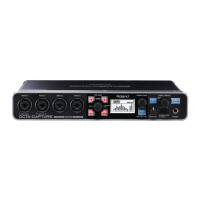47
Output Mixer A–D
Here you can control the balance of the ve stereo channels of audio data sent from the computer,
and send it to the headphones or the monitoring section.
You can control the four output mixers independently.
Click a mixer select tab to switch among mixers A–D.
Screen
indication
Setting Explanation
LINK Stereo Link
If this setting is on, the mixer settings of the adjacent channel will be set so
they’re identical to those of this channel.
MUTE Mute Switches mute on/o.
SOLO Solo Switches solo on/o.
PAN Pan Species the panning of the sound.
Slider Adjusts the monitor level of the playback signal from the computer.
Master A–D
Here you can control the master output levels of the input mixer and the output mixer.
Screen
indication
Setting Explanation
LINK Link
If this setting is on, the master volume of the input mixer and output mixer
will be linked.
RETURN Return
Adjusts the send level to the reverb unit (input mixer A only). For more
about the reverb unit on/o and type settings, refer to “Reverb” (p. 49).
LINK Stereo Link If this setting is on, the sliders of the left and right channels will be linked.
Slider Adjusts the overall monitor level.

